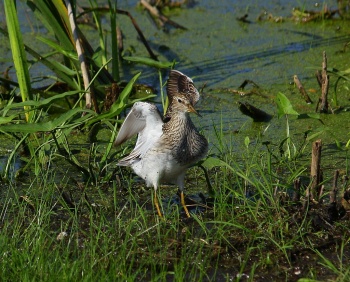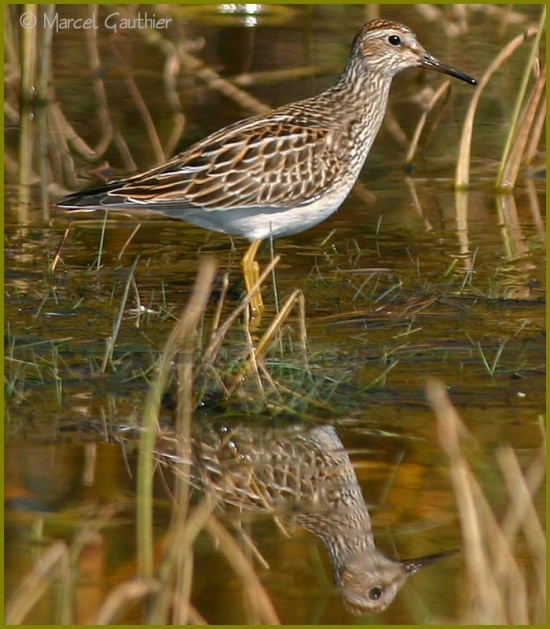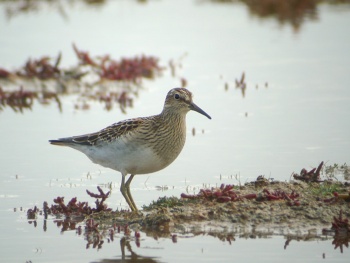(Picture of expanded air sac added) |
|||
| (13 intermediate revisions by 6 users not shown) | |||
| Line 1: | Line 1: | ||
| − | + | [[Image:Pectoral_Sandpiper.jpg|thumb|550px|right|Photo by {{user|Marcel+Gauthier|notason}} <br />Quebec, [[Canada]]]] | |
| − | [[Image:Pectoral_Sandpiper.jpg|thumb|550px|right|Photo by notason]] | + | ;[[:Category:Calidris|Calidris]] melanotos |
| − | |||
| − | |||
==Identification== | ==Identification== | ||
| − | + | 19-23 cm<br /> | |
| − | + | '''Adult''' | |
| − | + | *Bill: | |
| − | + | :*brownish-black | |
| − | + | :*black tip | |
| − | + | :*base often tinged olive-green or yellow-green, especially on lower mandible | |
| − | + | *Yellow legs | |
| + | *Colour of feet varies from brownish-yellow through greenish-yellow to olive-green | ||
| + | *Black patch on rump extending onto tail | ||
| + | *Thin, white wing stripe | ||
| + | *Dark brown Iris<br /> | ||
| + | Sexes similar in plumage but male 25–30% larger in weight than female. <br /> | ||
| + | '''Juvenile''': bill and feet are blackish-grey at fledging | ||
| + | [[Image:Pec-Sand-13.jpg|thumb|350px|right|Photo by {{user|John+Keep|John Keep}} <br /> Walton On The Naze, [[Essex]], [[England]], September 2007]] | ||
| + | ====Similar Species==== | ||
| + | Flight recalls [[Ruff]] | ||
| + | ==Distribution== | ||
| + | '''Breeds''' in north-east [[Siberia]] and northern [[North America]] from [[Alaska]] to Hudson Bay. '''Winters''' in southern [[South America]] from southern [[Bolivia]] and northern [[Argentina]] to [[Paraguay]], but in smaller numbers in Pacific to [[Australia]] and [[New Zealand]]. | ||
| − | + | In autumn most migrate via the Great Plains during July-September but large numbers gather at staging areas in south-east [[Canada]] and the north-eastern [[USA]] before flying south over the west Atlantic to [[South America]]. These birds are liable to meet with eastbound depressions bringing them across the Atlantic to [[Europe]]. | |
| − | + | [[Image:IMG 75141.jpg|thumb|350px|right|Expanded air sac used in flight display <br />Photo by {{user|Oppie|Oppie}}<br />[[Horicon Marsh]], [[Wisconsin]], [[USA]], July 2012<br />Click on image to enlarge]] | |
| + | Spring migration is mainly in April-early May and via the interior. | ||
| − | + | This is by far the most numerous Nearctic wader to occur in Europe and has been recorded in many countries from [[Iceland]] and the [[Faroes]] south to the [[Azores]] and east to [[Hungary]], [[Bulgaria]] and [[Romania]], also in [[Morocco]] and [[Israel]]. Annual in the [[British Isles]], the [[Azores]], [[France]] and [[Sweden]]. | |
| − | + | Over 100 records in the [[British Isles]] in some years, seen throughout [[Britain]] and [[Ireland]] with most in the south-west but significant numbers in the east suggesting a [[Siberia|Siberian]] rather than [[North America|North American]] origin for many birds. Recorded throughout the year but very rare in midwinter and dramatically peaking in September-October. | |
| − | |||
| − | |||
| − | |||
| − | |||
==Taxonomy== | ==Taxonomy== | ||
| + | This is a [[Dictionary_M-S#M|monotypic]] species<sup>[[#References|[1]]]</sup>. | ||
==Habitat== | ==Habitat== | ||
| − | + | Freshwater habitats, coastal areas with damp grassland, marshland and the margins of ponds and lakes. | |
| − | |||
==Behaviour== | ==Behaviour== | ||
| − | + | ====Diet==== | |
| − | + | These birds forage on grasslands and mudflats, diet includes insects and other invertebrates. | |
| − | These birds forage on grasslands and mudflats, | + | ====Vocalisation==== |
| − | + | '''Flight Call''': A throaty ''krik'' | |
| − | |||
| − | |||
| − | |||
| − | |||
| + | On the breeding grounds, male will blow up the throat area so the feathers stand on end; this results in a much darker impression of this area than normal. Additionally, a throat sac is filled with air that is then let out again resulting in a rhythmic series of hollow hoots, usually given in a display flight given by the male. | ||
| + | ==References== | ||
| + | #{{Ref-Clements6thAug11}}#Collins Field Guide 5th Edition | ||
| + | #Collins Bird Guide ISBN 0 00 219728 6 | ||
| + | #Parmelee et al. 1967 | ||
| + | {{ref}} | ||
==External Links== | ==External Links== | ||
{{GSearch|Calidris+melanotos}} | {{GSearch|Calidris+melanotos}} | ||
| − | + | <br /> | |
| − | + | {{Video|Pectoral_Sandpiper}} | |
| − | [[Category: | + | [[Category:Birds]] [[Category:Calidris]] [[Category:Videos]] |
Revision as of 20:49, 12 August 2012
- Calidris melanotos
Identification
19-23 cm
Adult
- Bill:
- brownish-black
- black tip
- base often tinged olive-green or yellow-green, especially on lower mandible
- Yellow legs
- Colour of feet varies from brownish-yellow through greenish-yellow to olive-green
- Black patch on rump extending onto tail
- Thin, white wing stripe
- Dark brown Iris
Sexes similar in plumage but male 25–30% larger in weight than female.
Juvenile: bill and feet are blackish-grey at fledging
Similar Species
Flight recalls Ruff
Distribution
Breeds in north-east Siberia and northern North America from Alaska to Hudson Bay. Winters in southern South America from southern Bolivia and northern Argentina to Paraguay, but in smaller numbers in Pacific to Australia and New Zealand.
In autumn most migrate via the Great Plains during July-September but large numbers gather at staging areas in south-east Canada and the north-eastern USA before flying south over the west Atlantic to South America. These birds are liable to meet with eastbound depressions bringing them across the Atlantic to Europe.

Photo by Oppie
Horicon Marsh, Wisconsin, USA, July 2012
Click on image to enlarge
Spring migration is mainly in April-early May and via the interior.
This is by far the most numerous Nearctic wader to occur in Europe and has been recorded in many countries from Iceland and the Faroes south to the Azores and east to Hungary, Bulgaria and Romania, also in Morocco and Israel. Annual in the British Isles, the Azores, France and Sweden.
Over 100 records in the British Isles in some years, seen throughout Britain and Ireland with most in the south-west but significant numbers in the east suggesting a Siberian rather than North American origin for many birds. Recorded throughout the year but very rare in midwinter and dramatically peaking in September-October.
Taxonomy
This is a monotypic species[1].
Habitat
Freshwater habitats, coastal areas with damp grassland, marshland and the margins of ponds and lakes.
Behaviour
Diet
These birds forage on grasslands and mudflats, diet includes insects and other invertebrates.
Vocalisation
Flight Call: A throaty krik
On the breeding grounds, male will blow up the throat area so the feathers stand on end; this results in a much darker impression of this area than normal. Additionally, a throat sac is filled with air that is then let out again resulting in a rhythmic series of hollow hoots, usually given in a display flight given by the male.
References
- Clements, JF. 2011. The Clements Checklist of Birds of the World. 6th ed., with updates to August 2011. Ithaca: Cornell Univ. Press. ISBN 978-0801445019. Spreadsheet available at http://www.birds.cornell.edu/clementschecklist/downloadable-clements-checklist
- Collins Field Guide 5th Edition
- Collins Bird Guide ISBN 0 00 219728 6
- Parmelee et al. 1967
Recommended Citation
- BirdForum Opus contributors. (2024) Pectoral Sandpiper. In: BirdForum, the forum for wild birds and birding. Retrieved 19 April 2024 from https://www.birdforum.net/opus/Pectoral_Sandpiper
External Links





